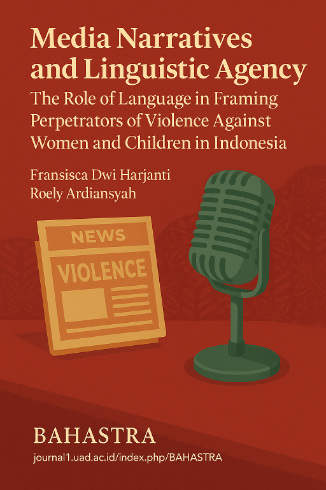Media narratives and linguistic agency: The role of language in framing perpetrators of violence against women and children in Indonesia
DOI:
https://doi.org/10.26555/bs.v45i2.1645Keywords:
Critical Discourse Analysis , Linguistic Agency , Media Narratives , News Reporting , ViolenceAbstract
Language plays a crucial role in shaping public perception, especially in news reporting. This study examines how grammatical constructions are used to frame perpetrators of violence against women and children in Indonesian social media news. Using Critical Discourse Analysis (CDA), it focuses on four types of sentence structures—active voice, passive voice, nominalization, and subordinate clauses—to uncover how language influences the representation of agency and accountability. A total of 15 news articles published between 2023 and 2024 from seven online media outlets (Detik.com, BBC.com, Kompas.com, Liputan6.com, Sumbar.Suara.com, Kompas.com, and Andika TV) were analyzed qualitatively. The results show that passive constructions dominate, followed by active voice, subordinate clauses, and nominalization. Active sentences highlight perpetrators and institutional actions, while passive and nominalized constructions often obscure agency and shift attention toward victims or events. Subordinate clauses emphasize victims’ experiences, evoking empathy but weakening perceptions of offender responsibility. These linguistic patterns reveal how news discourse can influence emotional and moral judgments about gender-based violence. The findings emphasize the need for journalists to adopt clear, active, and ethical language use and for media educators to integrate discourse awareness into journalism training to promote responsible and balanced reporting.
References
Alfaqara, W. (2024). The role of language in shaping Arab public opinion: A discourse analysis of media texts. Pakistan Journal of Life and Social Sciences, 22(2). https://doi.org/10.57239/PJLSS-2024-22.2.00729
Berrabah, B. (2020). Language as a vehicle and source of communication. Revue Plurilingue: Études des Langues, Littératures et Cultures, 4(1). https://doi.org/10.46325/ellic.v4i1.54
Brown, G., & Yule, G. (1983). Discourse analysis. Cambridge University Press.
Carvalho, D. W., Freire, M. T., & Vilar, G. (2012). Violence and the media: The case of Brazil. Revista Panamericana de Salud Pública, 31(5), 435–438. https://doi.org/10.1590/S1020-49892012000500012
Chan, E. Y., & Maglio, S. J. (2019). The voice of cognition: Active and passive voice influence distance and construal. Personality and Social Psychology Bulletin, 46(1). https://doi.org/10.1177/0146167219867784
Chan-Olmsted, S., Cho, M., & Lee, S. (2013). User perceptions of social media: A comparative study of perceived characteristics and user profiles by social media. Online Journal of Communication and Media Technologies, 3(4), 149–178. https://doi.org/10.29333/ojcmt/2451
Djourelova, M. (2023). Persuasion through slanted language: Evidence from the media coverage of immigration. American Economic Review, 113(3). https://doi.org/10.1257/aer.113.3
El Biadi, M., & Zih, H. (2022). Representation of Muslims through passivization and nominalization in British news media discourse: The Times Online newspaper as a case study. Journal of Muslim Minority Affairs, 41(4), 1–18. https://doi.org/10.1080/13602004.2022.2029012
Fairclough, N. (1998). Discourse and social change. Polity Press.
Ghanizadeh, A., Al-Hoorie, A. H., & Jahedizadeh, S. (2020). Critical discourse analysis. In Higher order thinking skills in the language classroom: A concise guide. Springer.
Gündüz, U. (2017). The effect of social media on identity construction. Mediterranean Journal of Social Sciences, 8(5). https://doi.org/10.1515/mjss-2017-0026
Halliday, M. A. K. (1972). Language structure and language function. In J. Lyons (Ed.), New horizons in linguistics. Penguin Books.
Harada, S., Miljan, L., & Cooper, B. (2005). Hidden agendas: How journalists influence the news. Canadian Public Policy, 31(2), 226. https://doi.org/10.2307/3552631
Harjanti, F. D., Tunik, L. M., & Ardiansyah, R. (2024). Language as a means of marginalization in news headline discourse on social media. NOBEL Journal of Literature and Language Teaching, 15(1), 85–104. https://doi.org/10.15642/NOBEL.2024.15.1.85-104
He, A. X., & Wittenberg, E. (2019). The acquisition of event nominals and light verb constructions: Acquiring event nominals and light verbs. Language and Linguistics Compass, 14(2), e12363. https://doi.org/10.1111/lnc3.12363
Hu, Y. (2023). Research on train derailment in Ohio by comparative analysis between CNN and Fox News. Advances in Education, Humanities and Social Science Research, 6(1), 433. https://doi.org/10.56028/aehssr.6.1.433.2023
Jost, P., & Viehmann, C. (2018). Who shapes the news? Analyzing journalists’ and organizational interests as competing influences on biased coverage. Journalism, 22(4). https://doi.org/10.1177/1464884918788270
Katz, S. R. (2020). American English grammar: An introduction. Routledge.
Keller, T. (2019). What is news? In television news (1st ed.). Routledge. https://doi.org/10.4324/9781351002660
KhosraviNik, M. (2010). Actor descriptions, action attributions, and argumentation: Towards a systematization of CDA analytical categories in the representation of social groups. Critical Discourse Studies, 7(1), 55–72. https://doi.org/10.1080/17405900903453948
Langston, K., & Peti-Stantic, A. (2014). The media and the message: The promotion and implementation of language planning in print, broadcasts, and on the internet. In Language planning and national identity in Croatia. Palgrave Macmillan.
Lloyd, M., & Ramon, S. (2016). Smoke and mirrors: U.K. newspaper representations of intimate partner domestic violence. Violence Against Women, 23(1), 94–113. https://doi.org/10.1177/1077801216634468
McQueen, D. A. (2008). BBC's Panorama, war coverage, and the 'Westminster consensus'. Westminster Papers in Communication and Culture, 5(3). https://doi.org/10.16997/wpcc.91
Meluzzi, C., Pinelli, E., Valvason, E., & Zanchi, C. (2021). Responsibility attribution in gender-based domestic violence: A study bridging corpus-assisted discourse analysis and readers' perception. Journal of Pragmatics, 185(1), 73–92. https://doi.org/10.1016/j.pragma.2021.07.023
Mokhberian, N., Abeliuk, A., Cummings, P., & Lerman, K. (2020). Moral framing and ideological bias of news. In Social informatics. Springer. https://doi.org/10.1007/978-3-030-60975-7_16
Monsumova, M. (2022). The role of language in news discourse. International Journal of Innovative Technologies in Social Science. https://doi.org/10.31435/rsglobal_ijitss/30062022/7809
Nothias, T. (2020). Representation and journalism. In Oxford research encyclopedia of communication. Oxford University Press. https://oxfordre.com/communication/view/10.1093/acrefore/9780190228613.001.0001/acrefore-9780190228613-e-868
Nurhaliza, S., Sikumbang, A. T., & Harahap, S. (2023). The use of journalistic language in the headlines of the Waspada daily newspaper. International Journal of Cultural and Social Science, 4(1). https://doi.org/10.53806/ijcss.v4i1.827
Pande, S. (2021). The ethics of reporting rape in India: A case study. In The Routledge companion to journalism ethics (1st ed.). Routledge
Price, L. T., Sanders, K., & Wyatt, W. N. (Eds.). (2021). The Routledge companion to journalism ethics (1st ed.). Routledge.
Qasim, S. (2018). The use of active and passive voice in the news language. ALUSTATH Journal for Human and Social Sciences, 218(1), 157–172. https://doi.org/10.36473/ujhss.v218i1.533
Sekhar, R. S. (2014). The concept of ‘news’: A reconsideration. DIU Journal of Humanities and Social Science, 2(1). https://doi.org/10.36481/diujhss.v.02i1.92szr057
Sholikhati, N. I. (2017). Analisis tekstual dalam konstruksi wacana berita korupsi di Metro TV dan NET dalam perspektif analisis wacana kritis Norman Fairclough. Jurnal Pendidikan Bahasa dan Sastra Indonesia, 6(2), 123–129.
Spangher, A., Ren, X., May, J., & Peng, N. (2022). NewsEdits: A news article revision dataset and a document-level reasoning challenge. arXiv. https://doi.org/10.48550/arXiv.2206.07106
Stubbs, M. (1983). Discourse analysis: The sociolinguistic analysis of natural language. University of Chicago Press.
Tenriawali, A. Y. (2018). Representasi korban kekerasan dalam teks berita daring Tribun Timur: Analisis wacana kritis. Totobuang, 6(1). https://doi.org/10.26499/ttbng.v6i1.71
van Gerven Oei, V. (2021). A reference grammar of Old Nubian. Orientalia Lovaniensia Analecta. Publisher.
Wang, X. (2023). Characteristics and differences of news mass communication between China and Russia. Trends in Research: New Insights and Opportunities, 12. https://doi.org/10.18411/trnio-12-2024-405
Wesely, J. K., Brown, E. R., & Phills, C. E. (2020). Words matter: A qualitative content analysis of campus crime alerts and considerations for best practices. Journal of American College Health, 70(1), 1–9. https://doi.org/10.1080/07448481.2020.1719114
Westerwick, S., & Taylor, L. D. (2008). The blame game. Communication Research, 35(6), 723–744. https://doi.org/10.1177/0093650208324266
Yang, C., Zhang, Y., & Zheng, Y. (2024). How grammatical constructions contribute to responsibility attribution in GBV coverage: A corpus-assisted study. Folia Linguistica. https://doi.org/10.1515/flin-2024-2052

Downloads
Published
Issue
Section
License
Copyright (c) 2025 Fransisca Dwi Harjanti , Roely Ardiansyah

This work is licensed under a Creative Commons Attribution-ShareAlike 4.0 International License.

1.jpg)






